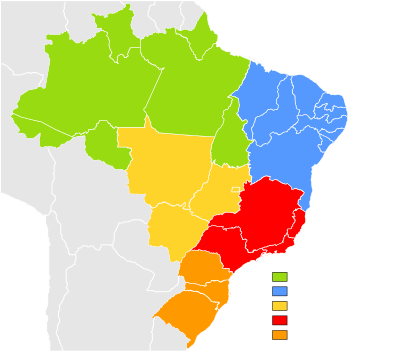2015 Brazilian drought

The 2015 Brazilian drought is an ongoing drought affecting the southeast of Brazil including the metropolitan areas of São Paulo and Rio de Janeiro. It has been described as the worst drought in 80 years.[1] The city of Sao Paulo appears to be affected the most and by the beginning of February many of its residents were subject to sporadic water cutoffs.[2]
Extent
Typically the rainy season starts in November,[3] but lack of rain in the 2014/15 season led to a major shortfall in the water supply in the states of São Paulo, Rio de Janeiro, and Minas Gerais.[1][4] With major reservoirs operating at their lowest capacity (the main reservoir system of Cantareira supplying São Paulo being at only 6% of its capacity in early February[1][5]) officials at São Paulo warned about extended rationing as water may run out before the next rainy season in November 2015.[3] In response, the water utility of Sao Paulo, Sabesp, has reduced water pressure in the system. It also started to impose punitive tariffs on users who use more than in previous years.[6] By early February residents had started to recycle and hoard water.[5]
By the end of February torrential downpours caused flooding in Sao Paulo, but the rain was not thought to be enough to result in significant replenishment of the water reservoirs.[7]
Potential causes
The drought situation is not unexpected. São Paulo is experiencing its third consecutive year of diminished rain falls.[3] A drought situation was already experienced in early 2014.[8] Water management is poor, pipes leak, and the infrastructure is old.[1] Past reports by scientists, environmentalists and technical experts were overridden by real estate developers and industrial and agricultural interests.[3] Further, lack of protection of watersheds and reservoirs has polluted water sources and made it difficult to bring usable water to the market.[3] The expansion of deforestation activities into the Amazon basin has been linked to the reduction of rainfall in the south of Brazil.[1][3][2]
Effect on hydroenergy generation
As seventy percent of Brazil’s electricity is generated by hydropower there is concern that a lack of water may also lead to energy rationing in addition to water rationing.[9] Analysts indicate that thermal plants will be filling the energy gap, but the switch will be costly.[6]
Potential solutions
Analysts see the crisis as a relatively short-term stressor but believe that it has the potential to be the "catalyst" to solve specifically São Paulo’s water problems.[6] Short term solutions include drilling more wells and more recycling of water. Long term solutions include the transfer of more water from additional river basins. Thus, a new 15 km connection has been authorized to be built to bring water from the Paraiba do Sul river basin to the Cantareira system.[6] Also, repair of leaking pipes is estimated to save 6% of total municipal water consumption in Sao Paulo.[6]
See also
References
- ↑ 1.0 1.1 1.2 1.3 1.4 Lourdes Garcia-Navarro, Paula Moura (February 10, 2015). "A Historic Drought Grips Brazil's Economic Capital". NPR. Retrieved February 13, 2015.
- ↑ 2.0 2.1 Simon Romero (February 16, 2015). "Taps Start to Run Dry in Brazil’s Largest City.". New York Times. Retrieved February 18, 2015.
- ↑ 3.0 3.1 3.2 3.3 3.4 3.5 Marussia Whately, Rebeca Lerer (February 11, 2015). "Brazil drought: water rationing alone won't save São Paulo". The Guardian. Retrieved February 13, 2015.
- ↑ "Brazil's most populous region facing worst drought in 80 years". BBC. January 24, 2015. Retrieved February 13, 2015.
- ↑ 5.0 5.1 "Brazil drought prompts drastic measures to save water". Al Jazeera. February 14, 2015. Retrieved February 14, 2015.
- ↑ 6.0 6.1 6.2 6.3 6.4 "Sao Paulo Drought Could Benefit Brazil". Stratfor. February 2, 2015. Retrieved February 18, 2015.
- ↑ Everton Fox (February 26, 2015). "Drought-stricken Sao Paulo hit by floods". Al Jazeera. Retrieved March 5, 2015.
- ↑ Phillips, Dom (21 May 2014). "São Paulo faces a critical water shortage as the World Cup prepares to kick off". The Guardian. Retrieved 3 August 2014.
- ↑ Joe Leahy (February 11, 2015). "São Paulo drought raises fears of Brazil energy crisis". Financial Times. Retrieved February 13, 2015.